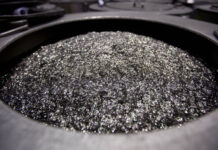
IT was the familiar shape of Neal Froneman that took the helm at Sibanye-Stillwater’s interim results presentation earlier this month, but what he had to say about a topic he normally favours was decidedly different.
Asked for his view on mergers & acquisitions, especially in gold where the firm’s South African assets are in structural decline, Froneman tetchily replied: “We are not focused on external growth. I thought I made that clear. We are keeping it to essentials.”
Essentials for Sibanye-Stillwater are, to put it bluntly, staying in business amid an indebted balance sheet. The group reported a cash outflow of R7bn in the six months ended June, a consequence of last year’s crash in platinum group metal (PGM) and nickel prices. Net debt increased by R6.8bn to R18.7bn. Before the results, the firm’s shares were 43% lower.
Sibanye-Stillwater has thrown the kitchen sink at cutting net debt to earnings, which measures its ability to repay loans. It presold unmined gold for R1.8bn, refinanced a revolving credit facility, and reduced its workforce, which, combined with deferred projects, saves it R7.4bn. A further $600m-$700m in prepaid gold and base metal sales is also in the works. Before these measures were finalised, lenders agreed to raise their debt covenants until end-2025.
Froneman is expansionist by nature. Ambition for more runs deep. In eight years, the group has spent R61bn on acquisitions, realising R105bn in cash returns, according to a report by RMB Morgan Stanley. “Simplistically, a successful aggregate return on investment,” it concluded. While this has established the group as a PGM producer, acquisitions such as Stillwater mine — for $2.2bn in 2016 — have started to bite, burning $286m in cash last year. A more recent acquisition, the Sandouville nickel refinery in France, lost $121m in cash between 2022 and 2023.
We are not focused on external growth. I thought I made that clear. We are keeping it to essentials – Neal Froneman, Sibanye-Stillwater
A long-standing growth project at Stillwater mine has already been abandoned, costing 287 jobs. But it will now halve existing production, putting a further 800 jobs at risk. Once the totem of Sibanye-Stillwater’s global ambition, Stillwater has become a sign of how quickly the best-laid plans can be wrecked by the market.
It’s painful for Sibanye-Stillwater but its swift response to the crisis has been met with plaudits, albeit cautious ones.
Sibanye-Stillwater’s closing net debt easily beat JPMorgan’s estimate — by $5.3bn, it said. RMB Morgan Stanley analysts, led by Christopher Nicholson, commented in a recent report: “We think the action taken to address the free cash flow burn at the US PGM assets, coupled with securing prepay/stream funding … will outweigh a soft result.” Crucially, Froneman and team have avoided the necessity of using shares to refinance the balance sheet — a key concern before the results.
Shares in Sibanye-Stillwater improved 18% two days after the results. According to Froneman, about half of this is to do with its agility and half is related to a PGM rally, led by palladium. It’s difficult to tell where one stops and the other starts, but Froneman tells the FM that cutting 200,000 ounces a year from palladium-dominant Stillwater will have a major effect on sentiment, which remains confoundingly influential in price setting, and worsen the supply deficit in the metal.
JVs in the pipeline?
Another concern for Sibanye-Stillwater is waning gold production. Its South African gold mines are ageing, putting into context Froneman’s unsuccessful attempt in 2021 to rustle up interest in a three-way merger with AngloGold Ashanti and Gold Fields. Production in 2024 will be 100,000 oz less than last year, after a shaft closure and underperformance.
Though gold is one of the metals that generated more cash for Sibanye-Stillwater than last year, the firm has had to shelve its R6.6bn Burnstone project. But showing willingness to do deals on existing assets, Froneman says there’s been inward interest in a potential joint venture on Burnstone. “It’s surprisingly very valuable, but we’re not hellbent on selling or retaining it. We will consider the right offer,” he says, adding there are “people fishing”.
Sibanye-Stillwater is not out of the woods yet – Arnold van Graan, Nedbank Securities
More imminent is a deal on the firm’s uranium assets, which Froneman says will materialise in the next three to six months. Greg Cochran, a former colleague from Froneman’s energy play Uranium One, is mandated to “engage with a number of parties. I can’t say more for [fear of] compromising the talks,” he says.
A joint venture on the gold and uranium assets is aimed at bringing in more money to the balance sheet. “Sibanye-Stillwater is not out of the woods yet,” says Nedbank CIB analyst Arnold van Graan.
Uppermost in shareholder minds is that the miner still has a project pipeline to fund including Keliber, a lithium new build in Finland. It’s a sign of Sibanye-Stillwater’s robustness that it was able to conclude a R10bn green funding deal in August.
There’s also its Rhyolite Ridge project in the US, another lithium project. If environmental and economic studies pass muster, the company will have to think about calling on its balance sheet yet again — something Froneman seems prepared to do. “This company will not be a dinosaur,” he says.
A version of this article first appeared in the Financial Mail.











